Infection in People
On This Page
- What are the clinical signs of an orf virus infection in humans?
- How do people become infected with orf virus?
- What should I do if I think I've become infected?
- Are people with a compromised immune system at greater risk from an orf virus infection?
- How can I keep from getting an orf virus infection?
- Are there any laboratory tests to diagnose orf virus infections in humans?
- For more information
What are the clinical signs of an orf virus infection in humans?
Infection with orf virus is usually confined to the epidermis (top layer) of the skin. Lesions (one to a few) or nodules will often occur on the fingers, hands, or the forearms. Lesions begin as small papules that will become ulcerative in nature. Orf virus lesions typically progress through six stages each lasting approximately one week. Other symptoms may include a mild fever, malaise (fatigue), or local swelling of lymph nodes. Lesions generally range in size from 2-3 cm but can be as large as 5 cm. They can be painful but usually resolve on their own without scarring.
How do people become infected with orf virus?
Orf virus infections in humans typically occur when broken skin comes into contact with the virus from infected animals or contaminated equipment. Activities that may put you at risk for infection include:
- Bottle feeding, tube feeding, or shearing sheep or goats
- Petting or having casual contact with infected animals
- Handling infected equipment such as a harness
- Being bitten by an infected animal.
Orf virus is not transmitted from one infected person to another.
Orf virus infections do not generate enduring immunity, a person can be infected multiple times throughout his or her life, but subsequent infections may be less pronounced and may heal more quickly.
What should I do if I think I’ve become infected?
Currently there is no approved treatment for an orf virus infection. However, the lesion can become infected with bacteria if not properly managed.
The lesion should be kept dry and covered to prevent a secondary infection with bacteria. While working with animals or during manual labor in which the lesion might get wet, use a watertight bandage. To promote healing, a non-weeping sore can be uncovered at bedtime or covered loosely if still weeping.
If you are experiencing pain, fever, or notice that the lesion is becoming rapidly larger or spreading, you should see your doctor.
A number of infectious agents can be transmitted from sheep and goats to humans. Some may even resemble orf in appearance but may be more serious. One such agent is anthrax, which can cause lethal disease in both goats and humans. You should seek medical attention if you notice a lesion that you cannot explain or the lesion is becoming rapidly larger.

Sore mouth in a person with a weak immune system. Photo courtesy Henry A. DeGroot, MD.
Are people with a compromised immune system at greater risk from an orf virus infection?
Persons whose immune systems are compromised or suppressed due to infection with HIV, lupus, or cancer therapy, etc., can develop serious symptoms following orf virus infection, including large tumor-like lesions, progressive disease, development of multiple lesions, or erythema multiforme reactions involving rashes on the mucous membranes and skin.
How can I keep from getting an orf virus infection?
People can become infected with orf virus by having direct contact with infected animals or through equipment contaminated with the virus. Some animals may or may not have visible lesions (sores) but may still be able to spread the virus.
Wear non-porous rubber or latex gloves when handling sheep or goats, especially when you have an open cut or sore and are handling the animals mouth/muzzle area.
Practice good hand hygiene by washing with clean, warm water and soap for at least 20 seconds, or by using a waterless alcohol-based hand rub when soap is not available and hands are not visibly soiled.
Are there any laboratory tests to diagnose orf virus infections in humans?
A laboratory test for orf virus in people is available at the Centers for Disease Control and Prevention (CDC). Specimens must be submitted for testing through a doctor or health department.
For more information
Please contact your doctor or your county or state health department. CDC also has tools to help with diagnosis and can be reached at (404) 639-4129.
- Page last reviewed: May 11, 2015
- Page last updated: May 11, 2015
- Content Source:


 ShareCompartir
ShareCompartir